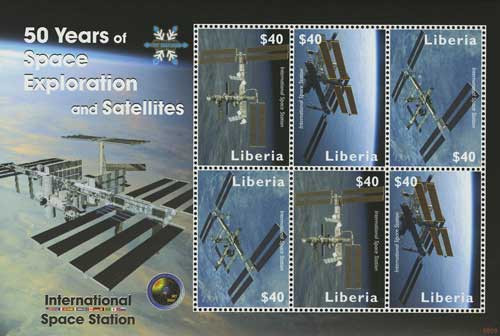
2008 Liberia International Space Station
# M11172 - 2008 Liberia International Space Station
$9.95
Stamp Sheet Highlight the International Space Station
This mint stamp sheet pictures the International Space Station built through the cooperative efforts of many countries.
In September 1993, Vice-President Al Gore, Jr. and Russian Prime Minister Viktor Chernomyrdin announced plans for a new space station built by the former Cold War enemies. The “Zarya” was the first section launched in 1998, followed quickly by the American “Unity.” Astronauts aboard the Space Shuttle “Endeavour” transported and connected the newer section to the Russian module. Astronauts Jerry Ross and James Newman attached the sections together during a series of space walks.
Europe, Japan, and Canada added to the Space Station, and it now consists of more than 15 modules. The European Space Agency contributed “Columbus,” a laboratory for conducting research. “Kibo,” the largest module on the station, was designed and built in Japan, and contains robotics from Canada. It’s the location for experiments including space medicine, communications, and biology. It has the capability to grow plants and observe fish. The robotic arm allows researchers to work with experiments outside the station. When no crew is available, staff on the ground in Japan can manipulate the robotics.
Much of the research conducted is aimed at long-term space flight. When the human body is exposed to weightlessness for an extended time, bone and muscle loss occurs. A flight to Mars would take at least six months, so these issues need to be addressed for the health of future space travelers.
The crews of the International Space Station run experiments developed by students. Classes may perform similar research on earth and communicate with astronauts through email or video conferencing. In the “Seeds in Space” program, young researchers on earth grew sunflowers from seeds that had flown in the station to examine the effects of space on plants.
Because of this international effort, our knowledge is increasing in human research, life sciences, and many other areas. The International Space Station is scheduled to orbit until at least 2020.
Stamp Sheet Highlight the International Space Station
This mint stamp sheet pictures the International Space Station built through the cooperative efforts of many countries.
In September 1993, Vice-President Al Gore, Jr. and Russian Prime Minister Viktor Chernomyrdin announced plans for a new space station built by the former Cold War enemies. The “Zarya” was the first section launched in 1998, followed quickly by the American “Unity.” Astronauts aboard the Space Shuttle “Endeavour” transported and connected the newer section to the Russian module. Astronauts Jerry Ross and James Newman attached the sections together during a series of space walks.
Europe, Japan, and Canada added to the Space Station, and it now consists of more than 15 modules. The European Space Agency contributed “Columbus,” a laboratory for conducting research. “Kibo,” the largest module on the station, was designed and built in Japan, and contains robotics from Canada. It’s the location for experiments including space medicine, communications, and biology. It has the capability to grow plants and observe fish. The robotic arm allows researchers to work with experiments outside the station. When no crew is available, staff on the ground in Japan can manipulate the robotics.
Much of the research conducted is aimed at long-term space flight. When the human body is exposed to weightlessness for an extended time, bone and muscle loss occurs. A flight to Mars would take at least six months, so these issues need to be addressed for the health of future space travelers.
The crews of the International Space Station run experiments developed by students. Classes may perform similar research on earth and communicate with astronauts through email or video conferencing. In the “Seeds in Space” program, young researchers on earth grew sunflowers from seeds that had flown in the station to examine the effects of space on plants.
Because of this international effort, our knowledge is increasing in human research, life sciences, and many other areas. The International Space Station is scheduled to orbit until at least 2020.











